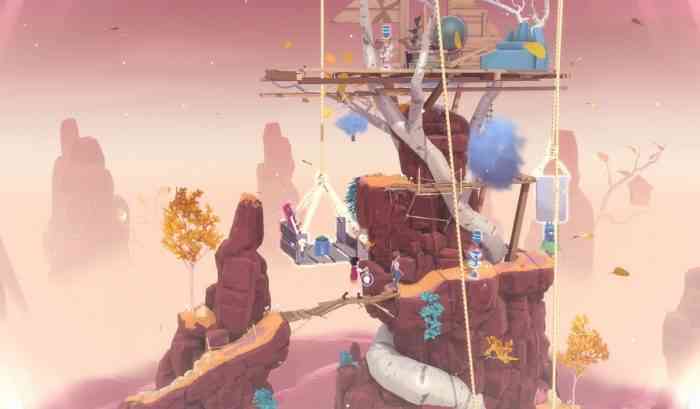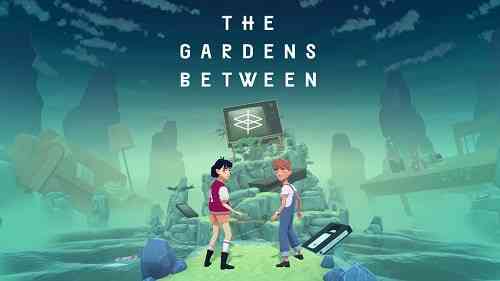The Gardens Between Notes Review
Do you remember that friend from your childhood? If you need a reminder, they are the one you made at camp that summer, or the kid you laughed with during swimming lessons, or the one who transferred from your school one year. The Gardens Between tells the story of best friends Arina and Frendt, reliving their time together (quite literally) before one of them moves away. It’s a straightforward story, acting as a backdrop to the game’s highlight: it’s deceptively simple, creative gameplay.
It’s a somber start to a rather whimsical game as next-door neighbours Arina and Frendt sit in their treehouse together on a last rainy night. However, as these friends sit together, a glowing ball of light appears between them and they are transported to a fantastical island, its shores scattered with giant moving boxes. The island is one of the games’ titular Gardens, and it is the first of many puzzles that the player will be solving. Immediately, The Gardens Between reminded me of my favourite mobile game, Monument Valley, as the player must shift a beautiful landscape around the protagonists, turning it around in your hands as if it were a puzzle box. You are guiding the characters along an emotional journey by solving the obstacles in front of them and seeing them through it.
Rewinding the Clock
The game’s premise is simple: you must guide Arina (who carries a lantern that can hold a ball of light) and Frendt (who activates switches in the world to change the placement of items in time) past obstacles to reach the end of a set string of events on each island. To complicate things, there are blocks that jump in a predetermined pattern around the island, smoke that helps and hinders, and flowers that provide the friends with a light if the lantern nears them. You can fast-forward and rewind the set sequence of events in each Garden, changing your actions or smaller sequences within the overarching set to get the light in the lantern to the top of the island. As you move the characters forward in time, the events of the island unfold forwards as well. If you move the characters backward, the events rewind — setting a specific way of getting past the obstacles and preventing confusion. It is about tracing a path forward to see what is about to happen and retracing your steps back to change something that would make the next sequence of events more optimal.

For example, on an early island, the lantern can be placed onto a block that propels itself upwards into a light flower when Arina moves forwards. But just moving forwards won’t reach the light, as in that moment during the set sequence of events, the block is on its second jump, leaping to the top of the island for an upcoming piece of the puzzle. The player needs to place the lantern on the block and move backward for the block to be in the right place at the right time. Moving backwards brings the block back on its first trajectory that passes the light flower. Once the lantern has the light inside, Arina can move forwards again to pick it up and carry on to the next puzzle. Above her, the block jumps to the top of the island, continuing onto the next part of the puzzle you caught a glimpse of earlier. Alright, it sounds like a lot, but it’s much easier to get the hang of than it seems. Most importantly, the game stops you from going back too far if you have successfully passed a section of the puzzle, narrowing your focus and cleanly preventing any unnecessary backtracking.
What’s truly remarkable about The Gardens Between is its creativity. At least one new mechanic is introduced every level, keeping each Garden fresh despite the simplicity of the variables. In most cases, the introduction of these mechanics are very intuitive. There is a Garden where Arina jumps onto the handle of a giant saw, which is stuck vertically through a plank of wood. In that point in time, Frendt stands on a lower piece of island, clearly where the plank would fall if it were sawn right through. Naturally, the player moves Arina forwards and back through time and has her jump over and over on the saw until the plank falls, making a bridge for Frendt. The achievement “Saw Through Time” pops up. The game also cleverly uses its own rules to introduce you to new ones — it is established within one level to put the lantern on a block on a platform powered by a pulley. There is a light flower at its base, and throughout the Garden, Arina and Frendt pull up the light to move past obstacles. Near the end of the puzzle, the two are standing at the top of the island without a light, so you assume you must place the lantern onto the block on the platform and pull up the light one more time. But the block suddenly jumps away before Arina can get there, and the game successfully teaches the player to bring her and the lantern down to reach the light instead. Most of the game is not very challenging; the joy largely lies in how delightful you discover the new mechanic to be. But despite how surreal and dreamy the game looks, due to the set nature of the game, the puzzle solving is in the end, quite methodical and linear. So although the game is creative, it does not allow the player to be and leaves no room for replayability. While this is not inherently bad game design, it does colour The Gardens Between with a rather discordant and conflicting mood, which lingers in the back of your mind as you play.
Naturally Creative
But it is incredible how creative the game gets with just light and void flowers, jumping blocks, thick smoke, and a lantern. A memorable Garden is one where several blocks are jumping around through time around a tree, in and out of different coloured paint cans. Only one passes by a light flower, and when Arina reaches a certain point up the tree, she sees three blocks painted with different colours. You are able to tell which of these blocks to put the lantern on by remembering (or rewinding to watch) which passed the light flower, and you are aided (or confused) by the paint colours. The later levels are truly where the game shines as we continue on to aligning the stars and to interacting with a child’s mural on the wall, à la A Link Between Worlds.

The art of The Gardens Between seems simpler than it actually is until you take a close look at how much detail these fantastical islands contain. Each object seemingly beached on their shores tell a small story, from the moving boxes to the blue cooler, literally bursting with ice cream and water guns that must have been used on a family picnic. The replay function also allows you to catch small details that otherwise might have gone unnoticed, like Arina and Frendt holding hands as they climb up the stairs of an island, or one of them running ahead and waving back to the other. Upon the completion of a few Gardens, you get a glimpse of Arina and Frendt’s friendship, a single moment of time put together with the various items from the last set of islands. When there is a saw and wooden planks in one, paint cans in another, pulleys and wheels in the last, and you see a small animation capturing Arina and Frendt in their homemade treehouse as a reward. Each of these scenes turns into a constellation, and you wonder if these two friends saw themselves in the stars at night. The ambient music is relaxing and the development team certainly knows it: after all, they made a selection of 10- to 15-minute trailers featuring this aspect of the game. The songs that play at the end of the game and the credits are especially beautiful, delicate and nostalgic.
Overall, The Gardens Between is not particularly complex or subtle with the linear-nature of its puzzle-solving and familiar story, but the level of creativity and depth the game reaches with its uncomplicated parts is not to be understated. It is a game to be played after a long day of school or work, when you might need to take a moment to remember simpler times.
**PC key provided by the publisher**
The Good
- Creative, constantly innovating gameplay
- Accessible, easy controls
- Intuitive puzzle-solving
The Bad
- Straightforward story
- No replayability

